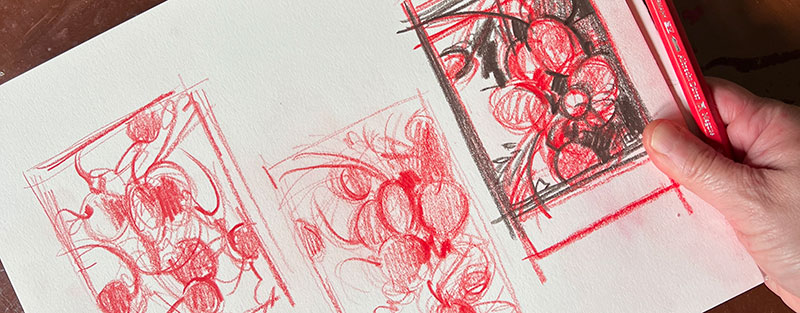See a demo of pencil techniques from beginning to end to create a compelling portrait.
Various techniques are explained, that can be used to build up three dimensional volume with pencil layering, blending, creating a diverse range of textures and marks, pencil grip, and more.

- Watch the 3 min. version
- Watch the 21 min. version
Tools like woodless pencils, kneaded erasers, and eraser sticks are explained. Demo led by Art Prof Clara Lieu.
We want to share your progress!

- Did you do this lesson?
- Submit to have your work to be posted here on this page or mentioned in a live stream.
Video Walkthrough
- Don’t stress about the accuracy of your portrait!
- Start the portrait with a very light gestural image, don’t start dark.
- A short drawing and a long drawing start the same way: blocking in the largest shapes.
- The upper eyelid is a good way to anchor the eye.
- Embed the eye into an eye socket and define the forms around the eye.
- Have fun with drawing!
- Drawing allows you to slow down and notice smaller things in life.
- “Rug of tone,” is placing large areas of tone to layer on top of.
- Look at hair as a mass, not as individual hairs you draw.
- Add the nostrils to show the three dimensionality of the nose.
- Don’t expect that you will get the results you want immediately.
- Changing your pencil grip to have more or less control.
- Using the eraser stick to pull out highlights in the eye.
- Looking at the transition between the forehead and the hair.
Prof Lieu’s Tips

I find that pencil grip is a very personal decision; not every pencil grip is going to work for everybody. That said, what I find is that most people haven’t tried multiple ways of gripping their pencil and that does become a limitation.

For many of us, we are used to that standard way of holding a pencil that we use when writing text. I grip my pencil very tightly when I write text, and that would be a disaster in terms of when I draw, so I really have had to experiment to find a good grip.

What’s tricky about my pencil grip that I demo is that it feels very, very shaky and unstable at first. Ultimately though it does provide a ton more flexibility in terms of the marks you make, but it does take time to get used to!
Art Supplies
Materials provided by
As a free educational source, Art Prof uses Amazon affiliate links (found in this page) to help pay the bills. This means, Art Prof earns from qualifying purchases.







